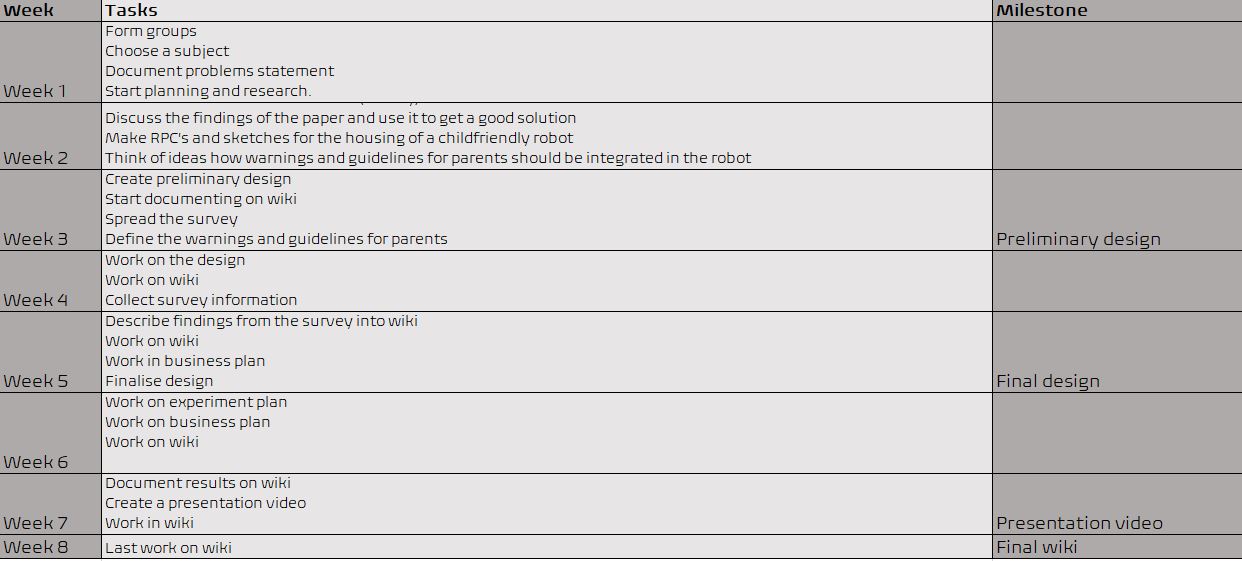PRE2020 3 Group9: Difference between revisions
TUe\20182065 (talk | contribs) |
TUe\20182065 (talk | contribs) |
||
| Line 39: | Line 39: | ||
== Abstract == | == Abstract == | ||
In this report, the design process of Rubby will be described. Rubby is an interactive robot that is designed in the COVID-19 pandemic to entertain children of 3, 4 or 5 years old and give them a playmate so parents can work from home without too many problems | In this report, the design process of Rubby will be described. Rubby is an interactive robot that is designed in the COVID-19 pandemic to entertain children of 3, 4 or 5 years old and give them a playmate so parents can work from home without too many problems | ||
---- | |||
== Problem statement == | == Problem statement == | ||
Revision as of 21:08, 13 February 2021
Groupmembers
| Name | Studentnumber | Department | Responsibility |
| Emma Allemekinders | 1317873 | Mechanical engineering | Final guideline for parents & Research robot-human interaction |
| Emma Höngens | 1375946 | Industrial Engineering & Innovation Sciences | Stakeholders survey & Research privacy |
| Paul Hermens | 1319043 | Mechanical engineering | Final wikipedia & Research data safety |
| Hidde Huitema | 1373005 | Mechanical engineering | Final design |
| Jos Stolk | 1443666 | Mechanical engineering | Final design |
Abstract
In this report, the design process of Rubby will be described. Rubby is an interactive robot that is designed in the COVID-19 pandemic to entertain children of 3, 4 or 5 years old and give them a playmate so parents can work from home without too many problems
Problem statement
Due to the Covid Pandemic, a lot of people have to work at home. Also children are at home and adults don’t have the time to work the whole day. Design a child friendly robot that can keep a toddler safe for an hour/longer.
Research fields: In order to make a childfriendly robot, there should be looked into the etics about child-robot interaction. A clear list of warnings and guidelines should be made for the parents to safely use a robot in their home. Also it should be researched whether parents would even buy a robot as nanny. Also a businessplan should be made for the robot. (costs etc).
| The robot has to monitor the child at all times = Privacy and Data safety etics |
| The robot should react on the emotions of a child to keep it at peace = Human-Robot interaction / Child-Robot interaction etics |
| The robot should function as a buddy to play with = Child-Robot interaction etics |
| An extra option could be an educational function, so that the child also learns something during playtime = Human-Robot education etics |
| What are the users, are there any users that would use a nanny-bot? And what are the advantages and disadvantages for the users involved |
| How much should a nanny-bot cost in order to be reasonable? |
Technical design: A child-friendly robot should be designed, the technical aspect will mainly focus on the housing of the robot. So it will mainly focus on the hardware rather than the software.
| What robot-shape is childfriendly? |
| How strong should the robot be? |
| How should the robot move smoothly? |
Logbook
Week 1
| Name | Total time | Break-down |
|---|---|---|
| Paul Hermens | ||
| Emma Allemekinders | ||
| Jos Stolk | ||
| Emma Höngens | ||
| Hidde Huitema |
Week 2
| Name | Total time | Break-down |
|---|---|---|
| Paul Hermens | ||
| Emma Allemekinders | ||
| Jos Stolk | ||
| Emma Höngens | ||
| Hidde Huitema |
Planning
